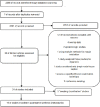Accuracy of frozen section in intraoperative margin assessment for breast-conserving surgery: A systematic review and meta-analysis
- PMID: 33735315
- PMCID: PMC7971883
- DOI: 10.1371/journal.pone.0248768
Accuracy of frozen section in intraoperative margin assessment for breast-conserving surgery: A systematic review and meta-analysis
Abstract
Background and objectives: It is well established that tumor-free margin is an important factor for reducing local recurrence and reoperation rates. This systematic review with meta-analysis of frozen section intraoperative margin assessment aims to evaluate the accuracy, and reoperation and survival rates, and to establish its importance in breast-conserving surgery.
Methods: A thorough review was conducted in all online publication-databases for the related literature up to March 2020. MeSH terms used: "Breast Cancer", "Segmental Mastectomy" and "Frozen Section". We included the studies that evaluated accuracy of frozen section, reoperation and survival rates. To ensure quality of the included articles, the QUADAS-2 tool (adapted) was employed. The assessment of publication bias by graphical and statistical methods was performed using the funnel plot and the Egger's test. The review protocol was registered in PROSPERO (CRD42019125682).
Results: Nineteen studies were deemed suitable, with a total of 6,769 cases. The reoperation rate on average was 5.9%. Sensitivity was 0.81, with a Confidence Interval of 0.79-0.83, p = 0.0000, I2 = 95.1%, and specificity was 0.97, with a Confidence Interval of 0.97-0.98, p = 0.0000, I-2 = 90.8%, for 17 studies and 5,615 cases. Accuracy was 0.98. Twelve studies described local recurrence and the highest cumulative recurrence rate in 3 years was 7.5%. The quality of the included studies based on the QUADAS-2 tool showed a low risk of bias. There is no publication bias (p = 0.32) and the funnel plot showed symmetry.
Conclusion: Frozen section is a reliable procedure with high accuracy, sensitivity and specificity in intraoperative margin assessment of breast-conserving surgery. Therefore, this modality of margin assessment could be useful in reducing reoperation rates.
Conflict of interest statement
No authors have competing interests.
Figures
References
-
- Fisher B, Anderson S, Bryant J, Margolese RG, Deutsch M, Fisher ER, et al.. Twenty-Year Follow-up of a Randomized Trial Comparing Total Mastectomy, Lumpectomy, and Lumpectomy plus Irradiation for the Treatment of Invasive Breast Cancer. N Engl J Med [Internet]. 2002. October 17 [cited 2018 Feb 14];347(16):1233–41. Available from: http://www.ncbi.nlm.nih.gov/pubmed/12393820 10.1056/NEJMoa022152 - DOI - PubMed
-
- Poggi MM, Danforth DN, Sciuto LC, Smith SL, Steinberg SM, Liewehr DJ, et al.. Eighteen-year results in the treatment of early breast carcinoma with mastectomy versus breast conservation therapy: the National Cancer Institute Randomized Trial. Cancer [Internet]. 2003. August 15 [cited 2020 Jan 6];98(4):697–702. Available from: http://www.ncbi.nlm.nih.gov/pubmed/12910512 10.1002/cncr.11580 - DOI - PubMed
-
- Veronesi U, Cascinelli N, Mariani L, Greco M, Saccozzi R, Luini A, et al.. Twenty-year follow-up of a randomized study comparing breast-conserving surgery with radical mastectomy for early breast cancer. N Engl J Med [Internet]. 2002. October 17 [cited 2018 Feb 14];347(16):1227–32. Available from: http://www.nejm.org/doi/abs/10.1056/NEJMoa020989 - DOI - PubMed
-
- Wright MJ, Park J, Fey J V, Park A, O’Neill A, Tan LK, et al.. Perpendicular inked versus tangential shaved margins in breast-conserving surgery: does the method matter? J Am Coll Surg [Internet]. 2007. April [cited 2020 Jan 6];204(4):541–9. Available from: http://www.ncbi.nlm.nih.gov/pubmed/17382212 10.1016/j.jamcollsurg.2007.01.031 - DOI - PubMed
Publication types
MeSH terms
LinkOut - more resources
Full Text Sources
Other Literature Sources







